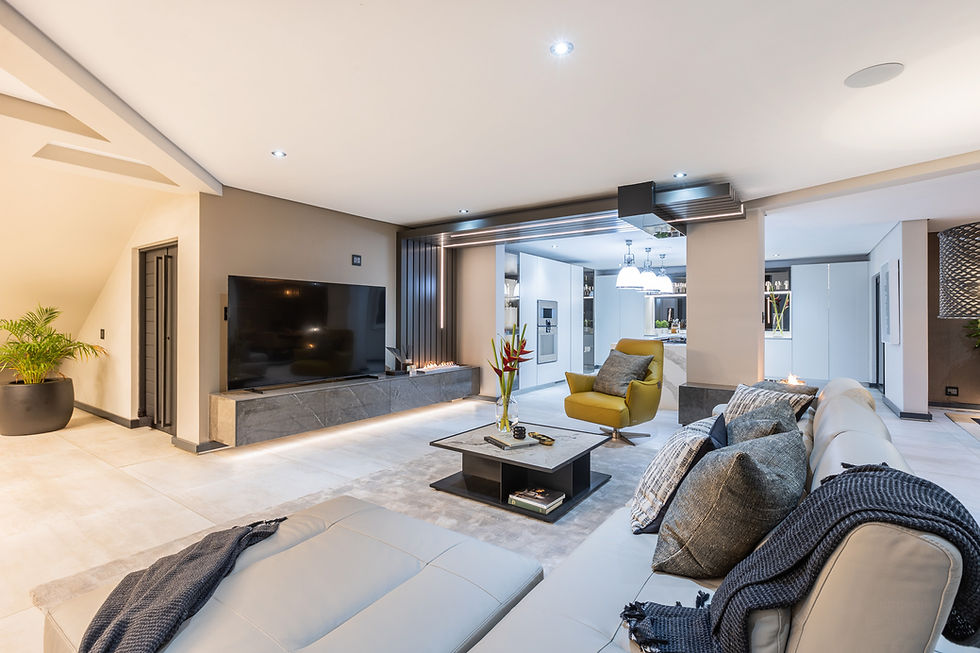The Role of Built-In Furniture
- Theo Arewa-Bothma

- Jun 22
- 7 min read
How Custom Built-In Furniture Enhances Luxury Interiors Through Space Optimisation, Seamless Design, and Personalised Detail
Picture this: a sunlit living room in the heart of Cape Town’s Atlantic seaboard. Floor-to-ceiling windows frame the ocean’s rhythmic swell, while an elegantly recessed library wall, clad in matte-finished walnut, mirrors the serenity of the sea. There are no bulky free-standing units to disrupt the view. No clutter. Just form, flow, and flawless function.
This is the power of built-in furniture.
More than just cabinetry or shelving, built-ins are the silent sculptors of a refined space. They turn the everyday; storage, seating, and display, into moments of intentional design. For the discerning home-owner, they offer not just solutions, but statements: tailored, timeless, and completely in sync with both the architecture and the way you live.
In this article, we explore how integrated furniture is more than just a design detail. It’s a philosophy, one that responds to spatial challenges with elegance and elevates interiors into cohesive, curated environments. Whether you're reimagining a penthouse pied-à-terre or a secluded countryside estate, bespoke built-ins are the key to unlocking luxury that feels effortless.
Maximising Space & Flow
Built-ins are like architectural choreography, each element placed with purpose to create harmony between movement, form, and function.
Every interior has its blind spots. An awkward corner that gathers dust, a shallow recess that becomes a graveyard for forgotten décor, or a circulation path that’s just shy of gracious. Left unaddressed, these pockets of potential can break the rhythm of a room. Enter the built-in, not as filler, but as a strategic reimagining of space.
At Studio 8687, we often approach built-ins the way a couturier approaches a bespoke suit. We study the posture of the room, the natural lines of flow, and then shape every element to complement its structure.
Built-ins can unlock vertical space, too. Think of an integrated headboard that stretches from floor to ceiling, concealing ambient lighting, reading nooks, and even hidden storage, all while elongating the room’s visual proportions. Or a staircase wall clad in seamless oak panels that house a cloak cabinet, shoe storage, and display niches, transforming transition into experience.
And let’s not forget function. In a world where luxury often lives in the details, custom seating that folds away flush with the wall, or kitchen islands with slide-out prep stations, offer tactile delight alongside visual polish.
For high-net-worth individuals accustomed to tailored environments, the question isn’t “What can I fit in this space?” but rather, “What can this space become?” Built-ins answer that with quiet intelligence, turning square meters into sculpted moments.
Seamless Architectural Integration
When done well, built-ins are invisible luxuries, the kind that whisper refinement rather than shout for attention.
Great interior design doesn’t start with decoration. It begins with architecture. And the most exceptional built-in furniture doesn’t merely sit within a room; it belongs to it, echoing its rhythms, respecting its lines, and enhancing its spatial integrity.
We often say that the best interiors are symphonies of alignment. In one of our recent projects nestled in the Serengeti Golf and Wildlife Estate, a sweeping open-plan living space featured bold architectural gestures; strong horizontal beams, recessed ceiling planes, and expansive glazing. To complement this language, we designed built-in shelving and cabinetry that mirrored those same lines: long, low, and linear, finished in a soft matte graphite to harmonise with the steel window frames. The result? A sense of visual calm and spatial logic that you feel before you even notice it.
Seamless integration is about more than just matching finishes. It’s about considered transitions. The grain of a timber panel continuing uninterrupted across the wall and cupboard. A TV unit so finely recessed that its presence disappears when not in use. Or joinery that follows the curve of an architectural arch, inviting touch as much as admiration.
Consider also the elimination of visual noise: no protruding handles, no clunky edges. With touch-latch mechanisms and recessed channels, built-ins can become monolithic forms, quiet sculptures that anchor a space. It’s these gestures, almost imperceptible at first glance, that speak to true luxury.
For our clients, whose homes often blur the boundaries between architecture and art, this level of integration isn't just aesthetic, it's emotional. It speaks of restraint, of intentionality, of homes designed not for trend but for timelessness.
So we ask: Where in your home could a built-in vanish, not to be forgotten, but to become so naturally embedded that it feels as if it was always meant to be there?
Enhancing Architectural Detail & Mood
Built-ins are not merely functional; they are an extension of the home’s soul, shaping how a space feels as much as how it performs.
Luxury is as much about atmosphere as it is about aesthetics. It’s the quiet confidence of a room that knows what it is, where every line, light, and material speaks in harmony. And few elements influence a space’s character more profoundly than built-in furniture designed to elevate mood and amplify architectural detail.
In more minimalist settings, built-ins can serve as subtle punctuation. A linear fireplace surround with integrated display shelving, finished in honed travertine, becomes both hearth and horizon line, grounding the room while keeping the visual language restrained. These moments of integration allow for material storytelling: the juxtaposition of warm timber against cool stone, or brushed bronze detailing tracing a shadow gap like jewellery on a tailored suit.
Lighting plays a pivotal role too. Recessed LEDs, backlit shelves, or softly glowing toe kicks create a sense of depth and intimacy, transforming static joinery into dynamic spatial experiences. The effect is not unlike stage lighting: guiding the eye, setting the tone, heightening the emotional resonance of a room.
For high-net-worth clients, whose homes often reflect their world-view, these gestures become signatures. Whether it’s a mirrored bar nook that opens into a hidden lounge, or a textural wall of fluted timber that shifts subtly in light throughout the day, built-ins have the power to tell stories without words.
And so we ask: What mood do you want your home to evoke? Serenity? Drama? Warmth? Confidence? Whatever your answer, there’s a built-in waiting to bring that feeling to life; quietly, masterfully, and utterly bespoke.
Personalisation & Brand Narrative
In the hands of a skilled designer, built-ins become more than furniture; they become chapters in the story of a life well-lived.
For the clientele we serve, luxury isn’t simply about what’s expensive, it’s about what’s meaningful. A truly bespoke interior doesn’t just reflect taste; it reflects identity. And built-in furniture, when thoughtfully designed, offers a canvas for personal narrative, woven subtly into the fabric of a space.
Personalisation lives in the details. A monogrammed drawer pull. A concealed wine cabinet engraved with the family crest. Built-ins allow for layers of intimacy, hidden compartments, tactile materials, and design decisions known only to the home-owner. These touches don’t scream status; they whisper legacy.
More than ever, our clients are seeking homes that reflect not just where they are, but who they are. And built-ins offer that unique opportunity to embed values, heritage, and lifestyle preferences directly into the structure of the home. Whether it's a meditation alcove integrated into a primary suite, or a jewellery drawer lined with leather from the same atelier as a favourite handbag, these moments elevate design into something deeply personal.
It’s also about alignment with lifestyle. An art collector may require climate-controlled built-in vitrines. A philanthropist might request a hidden writing desk to house handwritten correspondence. A frequent entertainer might prefer a fully integrated bar that transforms with the push of a panel. These aren’t just features; they’re expressions of identity.
So, we invite you to consider: What is the story your home should tell? And how might a built-in help you tell it, discreetly, beautifully, and entirely your own?
Sustainability & Material Innovation
Today’s true luxury is not only about how something looks or feels, but how responsibly it was made, and how well it will live into the future.
In a world increasingly shaped by environmental consciousness, sustainability is no longer a secondary consideration; it is a defining principle of modern luxury. And nowhere is this more elegantly expressed than through custom built-in furniture designed with longevity, responsibility, and ingenuity in mind.
Built-ins also offer an inherent advantage when it comes to reducing waste. Because they are designed with precision for a specific space and purpose, they eliminate the overproduction and redundancy typical of off-the-shelf furniture. And when they are constructed using sustainably sourced materials; FSC-certified wood, low-VOC finishes, rapidly renewable resources like bamboo or cork, they become quiet stewards of a lighter environmental footprint.
Innovation plays a starring role, too. We’ve begun integrating modular elements into our built-in designs; sections that can be adapted, reconfigured, or even repurposed should your needs evolve. Imagine a children’s play nook that transforms into a reading alcove. Or a built-in desk that detaches and becomes a free-standing console when relocating to a new residence.
Materiality, when considered sustainably, is an act of reverence, for the environment, for craftsmanship, and for the people who inhabit the space. And this reverence aligns deeply with the values of many of our clients: those who seek enduring beauty but also ethical elegance.
So we pose this thought: What if the next built-in in your home didn’t just fit your aesthetic vision, but your values, too? A piece that looks forward while still feeling like home.
Built-in furniture is more than a design choice; it is a design philosophy.
Across every project we touch, one truth consistently reveals itself: spaces that feel effortless are the result of deep intentionality. Built-ins embody that ethos. They shape how we move, what we see, and how we live, often without demanding our attention. And that is precisely their power.
Whether resolving spatial inefficiencies, echoing architectural rhythms, enhancing mood through material and light, or becoming vessels for personal meaning, built-ins allow interiors to transcend the expected. They speak to a level of refinement that goes beyond style; toward lifestyle, heritage, and vision.
At Studio 8687, we design with longevity in mind, not just in durability, but in relevance. Built-ins, at their best, are timeless. They aren’t furniture to be replaced; they are design gestures to be lived with, appreciated, and passed down. This is where true luxury resides, not in excess, but in elegance tailored to you.
So as you consider your next interior evolution, ask yourself not just what you want to include, but how you want to live. Because the spaces we inhabit shape our experience. And the best ones, built with care, precision, and soul, shape us right back.













Comments